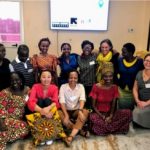Pay Attention: Child Marriage in Emergency
Child marriage, a formal or informal union of a child before the age of 18, has impacted 650 million women throughout the world. While data show that the rate of child marriage globally has decreased, refugees in emergency settings are a group that cannot be ignored. There are 68.5 million refugees, half f that number being children, throughout the world. Girls in these emergency settings are particularly vulnerable due to challenges that include a lack of access to formal schooling, gender-based violence, and cultural norms that infringe on girls’ autonomy. According to studies conducted with refugees from Syria, Uganda, and Myanmar by the Women’s Refugee Commission, the United Nations Population Fund (UNFPA), and other scholars, these challenges make refugee girls particularly vulnerable to child marriage. Increased attention to this population is needed to address and prevent this practice.
Refugee girls or their families are often from countries where child marriage may still be a cultural practice. Two-thirds of all refugees are from countries (Syria, Afghanistan, South Sudan, Myanmar, and Somalia) where child marriage is a common cultural practice. While refugees may flee to host countries that have created laws to address child marriage, many refugees travel from countries where it may be common cultural practice and may bring that cultural practice with them to a refugee camp.
Girls in emergency settings such as refugee camps are at a high risk of child marriage due to additional social and economic factors resulting from their refugee status. Due to factors like heightened poverty, lack of access to formal education and pre-existing cultural norms, girls in refugee camps are at a high risk of child marriage. Families in refugee camps, due to lack of resources, may choose or may be forced to marry their girls at young ages, due to financial insecurity.
What can be done to prevent child marriage among refugee girls? Take a holistic approach to interventions: Understanding the girl, her community, ideologies, existing policies, and groups that influence a girl’s autonomy, including marital decision-making, must be taken into account when developing effective prevention interventions to combat child marriage. Below is a visual representation of these systems surrounding a girl located in Kakuma Refugee Camp in Northern Kenya.
Fatima, pictured above, fled Somalia and now resides in Kakuma with her family. Fatima is embedded in six complex and interacting systems that influence her life. Fatima’s family, her religion, the United Nations (UN), and Kakuma Refugee Camp have the most proximate influence on her daily life, while the community of Kakuma, the Kenyan government and policies, and United Nations High Commissioner for Refugees (UNHCR) policies have an indirect, but still very present influence on Fatima’s life. Cultural norms of the host country, values, and beliefs of the UNHCR, Fatima’s culture from Somalia, as well as the war that resulted in her becoming a refugee all influence Fatima’s autonomy. Understanding how these systems collectively influence Fatima’s autonomy and her risk of child marriage can provide a stronger insight to guide intervention development so they may more effectively prevent child marriage.
Authored by: Leslie Gautsch, Ph.D. student in Education Studies
References:
- Child marriage. (2018, August 07). Retrieved August 14, 2018, from https://www.unicef.org/protection/57929_58008.html
- Girls Not Brides. (n. d.). About child marriage. Retrieved August 16, 2018, from https://www.girlsnotbrides.org/about-child-marraige/
- United Nations (2018). Figures at a Glance. Retrieved from http://www.unhcr.org/en-us/figures-at-a-glance.html
- Sperling, G. B., & Winthrop R. (2016). What works in girls education: Evidence for the world’s best investment. Washington, D. C.: Brookings Institution Press.
- Schlecht J, Rowley E, Babirye J (2013). Early relationships and marriage in conflict and post-conflict settings: vulnerability of youth in Uganda. Reproductive Health Matters, 41.
- United Nations Population Fund (2017, January 31). New study finds child marriage rising among most vulnerable Syrian refugees. Retrieved from https://www.unfpa.org/news/new-study-finds-child-marriage-rising-among-most-vulnerable-syrian-refugees
- Refugee Statistics| USA for UNHCR (2018). Retrieved August 2, 2018 from https://www.unrefugees.org/refugee-facts/statistics/
- Central Bureau of Statistics/UNICEF, Pan-Arab Project for Family Health/League of Arab States, Syrian Arab Republic Multiple Indicator Cluster Survey: Monitoring the situation of children and women, 2006.
- Parsons, J., Edmeades, J., Kes, A., Petroni, S., Sexton, M., & Wodon, Q. (2015). Economic Impacts of Child Marriage: A Review of the Literature. The Review of Faith & International Affairs, 13(3), 12-22. doi:10.1080/15570274.2015.1075757.
- Name has been changed – Fatima’s image provided by Clare Morneau, founder of Kakuma Girls.
- Bronfenbrenner, U. (1979). The economy of human development. Cambridge, MA: Harvard University Press.




